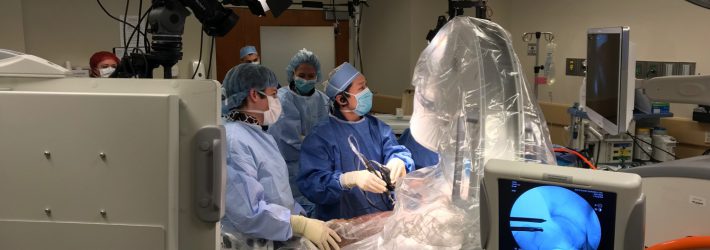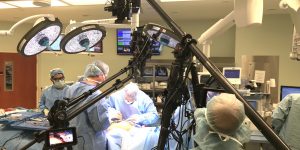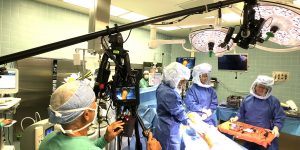Stepping Into The Surgeon’s Eyes

The First Precept for Shooting Outstanding Surgical Video
Some years ago I was involved in the discovery and planning stages of a series of surgical video projects that were going to be created for and by the entire University of California ten-campus healthcare system. The essence of the project was to produce a multitude of surgical procedural programs shot with outstanding teaching surgeons in their fields, a kind of library or encyclopedia of surgical video. It was meant to become a gesture of media unity between all ten campuses.
I am sorry to say that the project evaporated after only a few months. The reasons why weren’t entirely clear. Funding? Politics? Herding cats? It was maybe too big a project to wrangle. As a line producer I was outside the UC system, so will probably never really know. It’s been a good decade since.
But the original effort was bold and the UC surgeon architects of the idea brought together five of us outside medical video producers into one room on an overcast morning in San Diego. We spent the whole day discussing pre-production planning and the list of surgeons and surgical procedures we were to launch this mountainous venture with. It was exciting, valiant, and would take many years to complete.
At the end of the day, one of the producers proudly showed the group of us an example of his surgical work, actually the only surgical program he had shot. As the program rolled we could see a surgeon in frame, in what we would call a medium shot in the film industry, sitting on a rolling stool, showing the surgeon’s head as well as his legs, and maybe his shoes on the floor, if I remember correctly, while the assistant held two Richardson retractors, spreading a four inch incision over the lateral femoral area. The wound was but a mere red spot on the screen, at an angle that didn’t even look down into the wound. The shot was handheld, I remember, noting the floating in and out movement. The camera never cut to enlarge the wound nor rendered a shot that a surgeon would want to visualize. Instrument handles were shown, but the tips buried in the wound as if in a hidden pincushion.
For seasoned surgical videographers, this was an obvious example that this cameraman did not understand what kind of shot would render the procedure relevant to discriminating surgical eyes. Nor did the surgeon know what kind of shot the cameraman was getting.
At the end of his program two of us delicately critiqued his shots, and somewhat visibly deflated, he obligingly accepted our ineluctable mentoring. I felt for him. I remembered suffering a similar wound once in middle school after submitting a broken science exhibit to the science fair that at first I was proud of.
Since that time I have had many occasions when I have been handed other videographers’ surgical footage to edit. Sometimes the footage was outstanding, but too often it reminded me of that guy’s program. Too often, even medical videographers miss the shots because they don’t know what they are looking at when it comes to surgery.
Not Knowing You’re Not Getting the Shot When You Think You Are
So my shared experience here is dedicated to those videographers that may have shot some surgical procedures, and know that shooting surgery is much more than just showing up for a shooting gig. The challenge in surgical video production is that the videographer that doesn’t realize he isn’t getting the shot, doesn’t know it until it is too late. My personal advantage is that I have years of experience as a surgical tech and have scrubbed in on every surgical specialty. I’ve seen it all, even if I haven’t done it all. Thinking like a surgeon is maybe not possible for you, but there are some principles you can follow that can help.
The First Precept of Outstanding Surgical Videography
Which brings me to what I might call the first precept of good surgical videography: As a cameraman, ask yourself continually what the surgeon wants to see, not what you think looks like surgery.
Indeed, it is an advantage to think like a surgeon and know what surgeons want to see at every step. But if you don’t have this knowledge the last thing you want to do is walk into the OR without doing your homework about the procedure, and expect the surgeon to guide you. Remember, above all else, the surgeon’s first concern is for the patient, not about your shots.
Four Basic Camera Positions
In surgical videography there are basically four camera positions: from the surgeon’s point of view, from the assistant’s point of view, anywhere from overhead and the sides, and into the wound or space with a scope of some kind.
What is not important to the viewer surgeon are those head-shots of people in the OR looking down into a hidden wound. That’s the kind of footage news crews seek but not surgical videographers. More important to surgeons is to see every aspect of the procedure in detail in a manner that any surgeon becomes unaware they are watching a video, yet is entirely absorbed by the procedure. They literally forget they are watching a video, it’s that good. That means the video does not get in the way.
Stepping Into the Eyes of the Surgeon
Surgical videography is rarely easy. And the smaller and deeper the wound, the more difficult it gets. But the most important first step for any videographer stepping into an operating room is to constantly ask the questions, “What does the surgeon want to see? What are the details that I can make show up even better than the surgeon can see with his own eyes?” Plan with the surgeon before the case. Ask the surgeon to notify you of the important details before those happen. Ask the surgeon to explain the procedure A to Z and talk about camera angles before placing a foot in the OR. Too often surgeons sprint through the procedure thinking you’re getting the shot.
Fear of Not Knowing What You are Looking At
One aid allowing the surgeon to see the shots you’re getting is to park a monitor in front of him so he can glance up every now and then. Regardless, don’t rely on the surgeon to always tell you the shot to get. That will drive him crazy. Know your frame. Know that zooming close-in on the detail is likely more desirable. Too often I am handed footage to edit from other videographers who don’t know what they are looking at. So they keep to the medium shot out of safety, instead of zooming in on the fine details, afraid that they will miss something. Well, they are actually missing the procedure by keeping the shot zoomed too far away.
Do Your Homework
If you are shooting from the surgeon’s point of view, it is always good to know if they are right or left handed, so that you can plan for the better camera angle. For certain procedures the active hand gets in the way too often, but for other procedures it is the forceps hand that tends to get in the way. From both surgeon’s and assistant’s vantage the head can be a challenge. We’ve all seen heads blocking the shot. Two cameras are always an advantage when fighting with heads-in-the-way.
Surgical Action is Almost Always at the Tips of the Instruments
Another very common mistake is when the cameraman does not see the tips of the instrumentation. No tips, no shot. It’s as simple as that. Where the tip is buried beneath the edge of the wound, out of sight, is the location of the true surgical action you are missing. Don’t think the handles are showing you the action. Become instrument tip oriented at all times. That’s what the surgeon wants to see. And yes, there is a time to focus on handles, and that’s when two cameras come in handy to capture it all.
Camera Jibs are Essential
Also, the only successful way to get shots in surgery is with camera jibs. You have to get over the patient without you yourself hovering over the patient. If you’re hovering, you are breaking the rules of sterile technique. I have seen several cameramen bring ladders into the OR to get up and over the patient to get the shot, but I personally feel this is not only dangerous, but the potential for compromising the patient is increased by doing this. Jib-arms are the perfect tool-set for getting surgical shots. However, most jibs are not designed for surgery. Don’t think just because you are renting any given jib-arm that you’ll be able to get the shots. Not so. I use two different kinds of jib-arms for most all procedures. Surgery demands very particular requirements for mobility and visualization, which I will lay out in another article.
Anatomic, Surgeon’s POV, Assistant’s POV, or Framed for Visualization
Ask your surgeon if he wants the shots oriented anatomically, or framed POV, or any other way. There are times when anatomic orientation of the camera is important. Sometimes this needs attending to only during particular points in the surgery. Be aware of crossing the proscenium if you’re using two cameras, and pay attention that the other camera is not set upside down to the other.
Know Enough Sterile Technique
What you can touch in the OR and can’t touch is an important thing to know. It’s important for patient safety. Also there are areas you cannot walk through during surgery in the OR. Ask the Circulating Nurse to set these guidelines for you. The Circulator is the boss of the operating room, so follow their instructions. I have heard too many horror stories of cameramen leaning on the sterile field. That is cause for getting kicked out of the OR. Maintaining sterility is much more important for the patient than your shots.
Do Your Homework
As well as keeping in mind what a surgeon would want to see, above all other considerations, do your homework and learn the procedure from A to Z before you step foot into the OR. YouTube is peppered with videos on most surgical procedures, and although the quality is mostly questionable in those programs, YouTube does serve as a repository for surgical technique and procedural steps.
Finally know that this little corner of my own surgical video experience is but a sliver of a very large pecan pie that makes up the profession of producing, directing, and editing surgical video procedures for academic programs, live broadcasts, and device industry video programs. And I haven’t even touched upon the technology here. And there will be more to cover on this same topic. But for now, keep this basic principle of stepping into the eyes of the surgeon with your next surgical video shoot and you will see the difference right away. I guarantee it.





